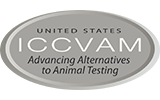Tox21 is a collaboration among groups within four U.S. federal organizations aimed at developing more efficient approaches to predict how chemicals may affect human health. Tox21 studies use assays that are run at higher throughput than traditional tests. Test approaches developed and data collected via this initiative may enable agencies to reduce reliance on animal data for assessing chemical safety.
The four groups participating in the Tox21 collaboration are ICCVAM members:
- U.S. Environmental Protection Agency
- U.S. Food and Drug Administration
- NIEHS Division of Translational Toxicology
- National Center for Advancing Translational Sciences (within NIH)
Tox21 projects and projects using Tox21 data are described below and throughout this report.
High-throughput transcriptomic analysis of Tox21 chemicals to further develop toxicity pathways
Gene expression profiling with alternative toxicological cell systems is a valuable tool to explore mechanisms of chemical interactions in biological systems. However, interpretation of these data for decision-making is challenging. EPA and NIEHS scientists are addressing this gap by building interpretable bridges between environmental chemicals and specific molecular targets of biological response such as nuclear receptors, enzymes, and transporters. A set of over 300 reference chemicals has been identified and procured to build robust transcriptomic data sets in various cell systems, including the U-2-OS human osteosarcoma cell line and differentiated cultures of HepaRG and 3D microtissues of primary hepatocytes, using the TempO-Seq™ technology for next-generation sequencing of cell lysates. Experiments survey a broad range of exposures to capture the initial stages of biological response to environmental chemicals that translate transcriptomic landmarks into reference chemical similarity relationships for elucidating mechanisms with data-poor chemicals. This efficient strategy holds the potential to greatly increase mechanistic understanding of adaptive responses to environmental chemicals at the gene expression level and inform next steps in toxicology research investigations.
Incorporating genetic susceptibility into developmental neurotoxicity screening via population diversity
The potential for neurotoxicity in children following exposure to environmental chemicals is of concern due to recent increases in the prevalence of neurological disorders such as attention deficit hyperactivity disorder and autism. Neurotoxicity risk for an individual can be influenced both by genetic background and by exposures to neurotoxic chemicals in the environment. To investigate the role of genetic diversity in susceptibility to neurotoxicity, scientists at EPA and FDA are using a genetically diverse set of cells to evaluate a curated set of chemicals with neurotoxic potential. Neural progenitor cells were derived from a set of mice bred to maximize genetic diversity, and a set of 135 cell lines was established, considered to be the minimum number of cell lines needed to quantitatively assess diversity in population responses. The panel of cell lines was exposed to eight concentrations of a 12-chemical test set. The intracellular structure of each treated cell was visualized using a high-content imaging assay called Cell Painting, which uses six fluorescent dyes to quantitatively describe cell features such as cell membranes, mitochondria, DNA and RNA, cytoskeleton, and Golgi bodies (Bray et al. 2016). Data analysis has enabled derivation of points-of-departure for chemical-induced intracellular morphometric endpoints and characterization of the variability in these points-of-departure across cell lines for each chemical. Analysis is ongoing to utilize a probabilistic framework to inform data-driven uncertainty factors that describe interindividual variability, allowing for adequate protection of genetically sensitive subpopulations. A paper describing the project is planned for submission in early 2025.
Performance-based validation of Tox21 assays
To use data generated by high-throughput screening (HTS) initiatives such as Tox21 and ToxCast in regulatory applications, the assays and models built from the assays must be validated based on their performance against the biological targets they query. This requires developing sets of reference chemicals that consistently yield reproducible results when assayed for these biological targets. Furthermore, the development of reference chemical sets needs to be streamlined and rapid enough to manage the tens to hundreds of assays that can help inform regulatory toxicity endpoints. To address this need, scientists at EPA and NIEHS developed a process to identify reference chemicals that consistently produce positive or negative results when tested in defined assays (Judson et al. 2019). Current work under this project in partnership with NCATS seeks to automate the generation of reference chemical lists without the need for new experimental tests or upfront literature review. The targets being examined are androgen receptor, estrogen receptor, glucocorticoid receptor, peroxisome proliferator-activated receptor gamma, progesterone receptor, retinoic acid receptors, thyroid hormone receptor, tumor protein p53, mitochondria toxicity, and cell stress pathways. The list of assays and reference chemicals generated through this process will be used to validate new assays or AOPs, which will improve chemical screening abilities when predicting toxicity. The project will produce a reference chemical selection workflow and an associated paper to be submitted for publication in 2024.
Retrofitting existing Tox21 HTS assays with metabolic capability
High-throughput screening (HTS) assays that have been run in the Tox21 testing program to date generally lack the metabolic activity found in living systems, which can potentially increase or decrease the toxicity of chemicals. As a result, HTS results may not accurately reflect in vivo activity. Scientists at EPA, NCATS, and NIEHS are using several approaches to address this problem: adding human or rat liver microsomes into the existing assays (Ooka et al. 2022), transfecting cells with mRNAs encoding human metabolic enzymes, or using metabolically capable human HepaRG cells. The retrofitted assays are then used to screen the Tox21 10K chemical library to identify chemicals that are either bioactivated or detoxified by metabolic activity. Chemicals that exhibit metabolism-mediated shifts in bioactivity are further screened to identify the responsible metabolic enzymes. This screening data can be used to build predictive models for identifying the CYP inhibition. A paper describing the results of the screening is planned for publication in 2024. Retrofitted assays are also being used to explore how metabolism might affect interaction of chemicals with the androgen receptor pathway; screening of candidate chemicals will be ongoing in 2024.
Expansion of pathway coverage by Tox21 HTS assays for better prediction of adverse drug effects
To date, Tox21 high-throughput screening (HTS) assays have focused primarily on selected nuclear receptor and stress response pathways. This relatively limited focus suggests that activity in other toxicity pathways has not been adequately assessed; it is likely that some unexplored pathways relate to unanticipated adverse drug effects. Therefore, expanding the coverage of biological responses by adding assays that probe under-represented pathways in the current Tox21 assay portfolio may improve the predictivity of Tox21 data. Scientists at FDA, NCATS, and NIEHS are systematically identifying these under-represented pathways in a data-driven approach and nominating assays for development and Tox21 chemical screening. The data generated will be used to build models for human toxicity prediction, focusing on common adverse drug effects such as drug-induced liver injury and cardiotoxicity. The initial survey identified targets and pathways of interest, including CYP450 metabolic enzymes and G protein-coupled receptors. In 2022 and 2023, HTS assays for the proposed new targets and pathways were screened against the Tox21 10K chemical library. Predictive models for hepatotoxicity and cardiotoxicity were built using chemical structure and Tox21 in vitro assay data (Ye et al. 2022). Predictions from the models are currently being validated in relevant assays. A second manuscript evaluating the impact of the newly generated assay data on improving model performance is under preparation and planned to be submitted in 2024.
Machine-learning models to predict nonspecific thiol reactivity in high-throughput screening assays
High-throughput screening (HTS) programs such as Tox21 gather data on chemical bioactivity in a variety of targets and activities to prioritize assays for further testing or better understand mechanisms of toxicity. However, interpreting such data is complicated by nonspecific chemical reactivity. To help address this problem, HTS assays have been developed to measure autofluorescence and data from these assays used to train machine-learning models to predict reactivity. EPA and NCATS scientists used a fluorescence-based HTS assay that identifies thiol-reactive compounds to screen 7,872 unique chemicals in the Tox21 10K chemical library (Patlewicz et al. 2023). Active chemicals were compared with profiling outcomes using structural alerts encoding electrophilic information. Random Forest classification models based on chemical fingerprints were then developed to predict assay outcomes. The model developed shows promise as a tool to screen untested chemicals for their potential electrophilic reactivity based solely on chemical structure.
Predictive toxicology of the retinoid signaling pathway
The developing child is vulnerable to genetic, pharmacological, or chemical disruption of the retinoid biochemical pathway, especially during early growth and differentiation of embryonic tissues. Susceptibility of this pathway to chemical disruption is an important regulatory concern for developmental and reproductive hazard identification. In this study, which involves all four Tox21 participating offices, Tox21 data are being mined and modeled to identify potential retinoid pathway disruptors. Results from a dozen Tox21 molecular targets mapping to retinoid pathway targets identified over 100 structurally diverse chemicals with relevant bioactivity. Computational tools and approaches are now being built to integrate these data with embryological knowledge and construct data-driven models for developmental hazard prediction. Recent publications from the project described:
- Identification of candidate reference chemicals for use in in vitro assays relevant to the pathway (Baker et al. 2022).
- A computational model for fetal skeletal defects potentially linked to disruption of retinoic acid signaling (Pierro et al. 2022).
- Application of in vitro to in vivo extrapolation (IVIVE) to characterize potency of chemicals interacting with the pathway (Chang et al. 2022a).
- Development and validation of a high-throughput assay measuring activity of the metabolic assay CYP26A1 (Sakamuru et al. 2024), and screening of a library of pharmacologically active chemicals with the assay.
Planned activities in 2024 include analysis of the CYP26A1 assay data, development and validation of assays measuring activity of additional CYP enzymes, further application of quantitative IVIVE for potency assessment, and evaluation of a cytokine array for profiling microglia activation.
Investigation of environmental determinants of pubertal timing in girls
Over the past decade, there has been a worldwide trend toward earlier breast development in girls. The rapid pace of this trend suggests the involvement of environmental factors. Scientists at NIEHS and NCATS are examining the potential effects of endocrine-disrupting chemicals on important components of the biochemical pathway responsible for pubertal timing. In these studies, 58 chemicals in the Tox21 10K collection were tested in human cell-based assays that measure activation or inhibition of the gonadotropin-releasing hormone receptor and kisspeptin receptor. These receptors are expressed in the hypothalamus and are important players in the control of pubertal timing. Chemicals that exhibited activity included chemicals known to be active in these pathways and chemicals for which this activity was novel; these were characterized further in other cell-based assays and molecular docking studies. Further studies are necessary to investigate whether exposure to these chemicals might play a role in the increasing prevalence of early puberty in girls.



